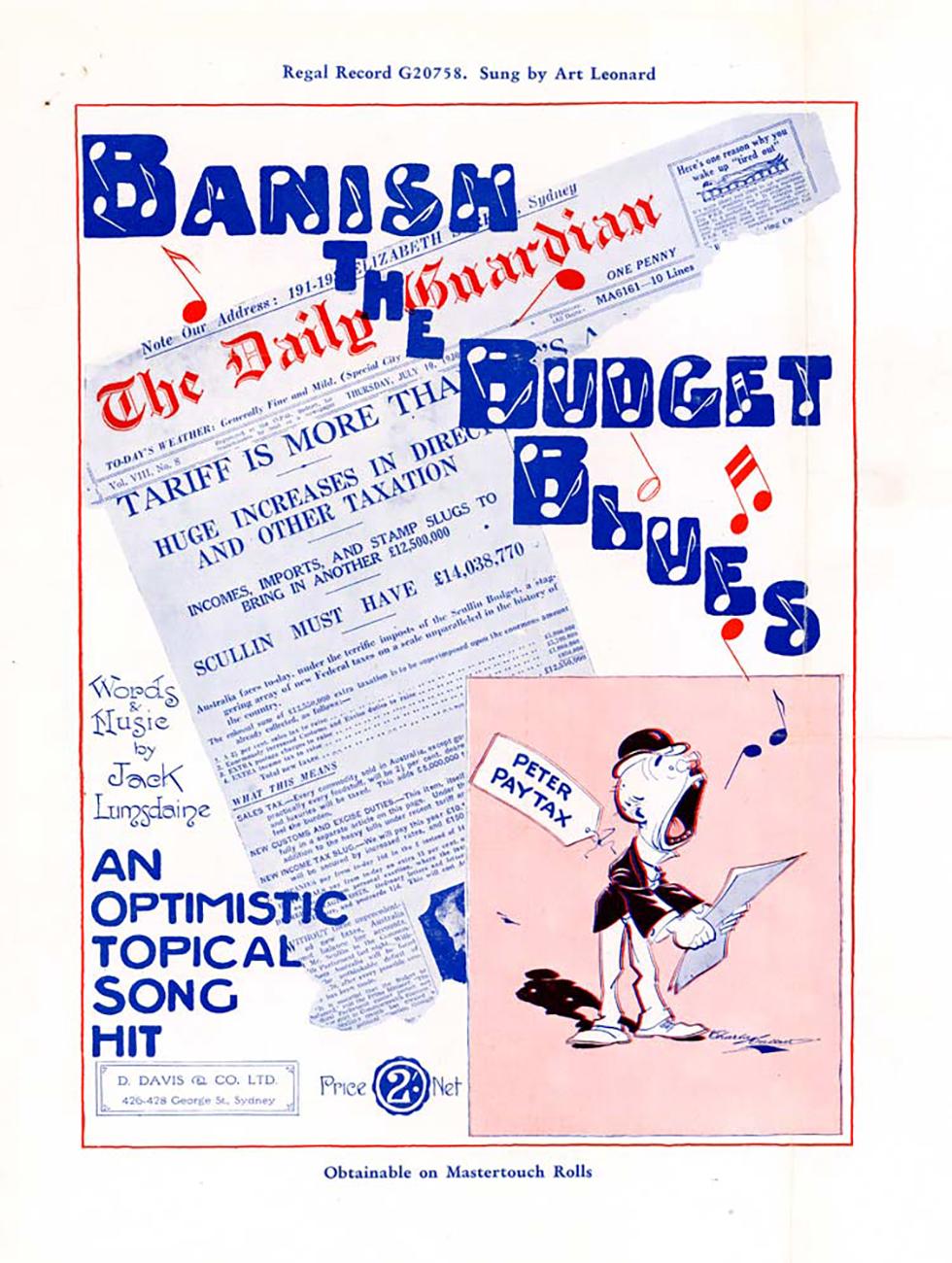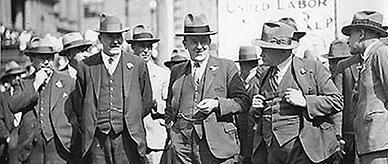


Transcript
[Illustrated front cover.]
[Header in small blue text:] Regal Record G20758. Sung by Art Leonard[.]
[Background: a photo of a newspaper clipping from 'The Daily Guardian'. Partially obscured headline reads 'TARIFF IS MORE THAN…'. This is followed by three subheadings. Subheading 1: 'HUGE INCREASES IN DIRECT AND OTHER TAXATION'. Subheading 2: 'INCOMES, IMPORTS, AND STAMP SLUGS TO BRING IN ANOTHER £12,500,000'. Subheading 3: 'SCULLIN MUST HAVE £14,038,770'.]
[Title in large blue font, with white music notes printed onto the thick blue lines of the letters:] BANISH THE BUDGET BLUES[.]
[In thin, decorative letters:] Words & Music by Jack Lumsdaine[.]
[Subtitle in bold capital letters:] AN OPTIMISTIC TOPICAL SONG HIT[.]
Price 2'. [two shillings] Net[.]
[There is a small box in the bottom left corner, printed to look like a stamp, with the text 'D. DAVIS & Co. LTD.', '426-428 George St, Sydney'.]
[In the bottom right corner of the page, taking up approximately a quarter of the page, there is superimposed a box with a pink background, with a cartoon drawing of a man singing. The is wearing a bowler hat, glasses, and suit jacket, holding a large sheet of paper, and he is labelled 'PETER PAYTAX'.]
[Footer:] Obtainable on Mastertouch Rolls[.]
About this record
This is the front cover of the song sheet for Banish the Budget Blues by Jack Lumsdaine, printed in blue, red and pink and priced at 2 shillings. An article from The Daily Guardian is used as an image. The headlines are partly obscured, but relate to taxation issues. They are: 'Tariff is more than ...', 'Huge increases in direct ... and other taxation', 'Incomes, Imports, and Stamp slugs to bring in another £12,500,000' and 'Scullin must have £14,038,770'. A caricature of a singing taxpayer, 'Peter Paytax', appears in an inset box.
Educational value
- This popular Australian song was written during the Great Depression, at a time of social and economic hardship. It was a response to the federal government's tough 1930–31 budget, which introduced sales tax on a number of items. By the late 1920s Australia was already in a financially precarious position due to high unemployment and a reliance on exports. By 1930, when this song was written, Australia was suffering from mounting unemployment, strikes and lowered wages.
- The song's comical take on taxation contrasts the bad economic news with the spirit and determination to overcome hardship and raise optimism during the Great Depression. It jokes about taxes on simple pleasures such as clothing, cigarettes and beer–items that for many helped alleviate the harshness of life. The new sales tax on these items would have been difficult to bear for much of the population at the time.
- The 1930–31 budget was handed down by Prime Minister James Scullin (1876–1953), who was also acting Treasurer. He presented his budget on 9 July 1930, eight months after taking office, following the forced resignation of treasurer Edward Theodore. The budget tried to address the crisis caused by the United States stock market crash, which had occurred days before Scullin took office. Scullin's budget raised income tax and introduced sales tax to fund more spending on public works.
- This song was written by Jack Lumsdaine (1895–1948), an Australian songwriter and vaudeville performer. At the time, vaudeville was a popular form of variety stage entertainment and Lumsdaine was already known for his music and a radio show Music while You Wait when he wrote this song. Much of his success was based on his understanding of public tastes and contemporary issues. He recorded the song Every Day is a Rainbow for Me with Sir Donald Bradman in the same year.
- Banish the Budget Blues appears to have been a well-known song, presumably popular because of the widespread effects of the new taxes. It was recorded by singer Art Leonard in Sydney in July 1930, and was also available as sheet music and on piano roll for player pianos. Described as 'an optimistic topical song hit' on the sheet music cover, it was played and sung at a time when singing around the piano was a popular recreational activity in Australian homes.
Acknowledgments
Learning resource text © Education Services Australia Limited and the National Archives of Australia 2010.
Related themes
Need help with your research?
Learn how to interpret primary sources, use our collection and more.



